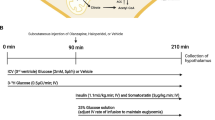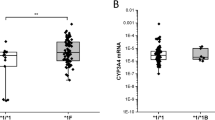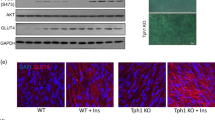Abstract
Patients taking atypical antipsychotics (AAPs), especially clozapine, are often associated with hyperglycaemia. Here, clozapine served as a representative agent for investigating how AAPs induce hyperglycaemia. In normal mice and mice fed a high fat diet (HFD), clozapine impaired glucose tolerance and glucose-stimulated insulin secretion (GSIS) following intraperitoneal glucose administration and increased plasma 5-HT levels. Intraperitoneal 5-HT administration also impaired glucose tolerance and GSIS in mice. In INS-1 cells, high 5-HT levels impaired GSIS, which was attenuated by the 5-HTR3 antagonist tropisetron or by silencing 5-HTR3a. The 5-HTR2a agonist TCB2 attenuated clozapine-induced GSIS impairment. Silencing 5-HTR2a or the 5-HTR2a antagonist ketanserin impaired GSIS. In mice, 5-HT administration impaired GSIS, which was attenuated by tropisetron but aggravated by clozapine. Clozapine increased plasma [2H]5-HT exposure following intravenous administration to mice. In HEK293-OCT1 cells, clozapine inhibited [2H]5-HT and MPP+ uptake. Clozapine or OCT1 silencing impaired 5-HT metabolism in mouse primary hepatocytes, demonstrating that clozapine increased plasma 5-HT levels via the inhibition of OCT1-mediated hepatic 5-HT uptake. Liver-specific silencing of OCT1 increased plasma [2H]5-HT exposure and 5-HT levels and impaired GSIS and glucose tolerance in mice. In conclusion, clozapine impaired GSIS and glucose tolerance by increasing plasma 5-HT levels via the inhibition of OCT1-mediated hepatic 5-HT uptake. Increased 5-HT impaired GSIS by activating islet 5-HTR3a. The antagonistic effect of clozapine on islet 5-HTR2a also contributed to GSIS impairment. The finding that clozapine-induced GSIS impairment was attributed to increased 5-HT levels via the inhibition of OCT1-mediated hepatic 5-HT uptake may partly explain hyperglycaemia caused by other AAPs.
This is a preview of subscription content, access via your institution
Access options
Subscribe to this journal
Receive 12 print issues and online access
$259.00 per year
only $21.58 per issue
Buy this article
- Purchase on SpringerLink
- Instant access to full article PDF
Prices may be subject to local taxes which are calculated during checkout









Similar content being viewed by others
References
Henderson DC. Atypical antipsychotic-induced diabetes mellitus: how strong is the evidence? CNS Drugs. 2002;16:77–89.
Scheen AJ, De Hert MA. Abnormal glucose metabolism in patients treated with antipsychotics. Diabetes Metab. 2007;33:169–75.
Cernea S, Dima L, Correll CU, Manu P. Pharmacological management of glucose dysregulation in patients treated with second-generation antipsychotics. Drugs. 2020;80:1763–81.
Grajales D, Ferreira V, Valverde ÁM. Second-generation antipsychotics and dysregulation of glucose metabolism: beyond weight gain. Cells. 2019;8:1336.
Pillinger T, McCutcheon RA, Vano L, Mizuno Y, Arumuham A, Hindley G, et al. Comparative effects of 18 antipsychotics on metabolic function in patients with schizophrenia, predictors of metabolic dysregulation, and association with psychopathology: a systematic review and network meta-analysis. Lancet Psychiatry. 2020;7:64–77.
Khokhar JY, Henricks AM, Sullivan EDK, Green AI. Unique effects of clozapine: a pharmacological perspective. Adv Pharm. 2018;82:137–62.
Henderson DC, Nguyen DD, Copeland PM, Hayden DL, Borba CP, Louie PM, et al. Clozapine, diabetes mellitus, hyperlipidemia, and cardiovascular risks and mortality: results of a 10-year naturalistic study. J Clin Psychiatry. 2005;66:1116–21.
Henderson DC, Cagliero E, Gray C, Nasrallah RA, Hayden DL, Schoenfeld DA, et al. Clozapine, diabetes mellitus, weight gain, and lipid abnormalities: a five-year naturalistic study. Am J Psychiatry. 2000;157:971–85.
Wang W, Bai MR, Jiang T, Li C, Li P, Zhou H, et al. Clozapine-induced reduction of l-carnitine reabsorption via inhibition/down-regulation of renal carnitine/organic cation transporter 2 contributes to liver lipid metabolic disorder in mice. Toxicol Appl Pharmacol. 2019;363:47–56.
Chang GR, Liu HY, Yang WC, Wang CM, Wu CF, Lin JW, et al. Clozapine worsens glucose intolerance, nonalcoholic fatty liver disease, kidney damage, and retinal injury and increases renal reactive oxygen species production and chromium loss in obese mice. Int J Mol Sci. 2021;22:6680.
Melkersson K, Jansson E. Effects of the atypical antipsychotic clozapine on insulin release in vitro. Neuro Endocrinol Lett. 28;6:854–60.
Liu XM, Wu ZX, Lian JM, Hu CH, Huang XF, Deng C. Time-dependent changes and potential mechanisms of glucose-lipid metabolic disorders associated with chronic clozapine or olanzapine treatment in rats. Sci Rep. 2017;7:2762.
BanKi CM. Alterations of cerebrospinal fluid 5-hydroxyindoleacetic acid, and total blood serotonin content during clozapine treatment. Psychopharmacology. 1978;56:195–8.
Schulz E, Fleischhaker C, Clement HW, Remschmidt H. Blood biogenic amines during clozapine treatment of early-onset schizophrenia. J Neural Transm. 1997;104:1077–89.
Ertugrul A, Ucar G, Basar K, Demir B, Yabanoglu S, Ulug B. Influence of clozapine on platelet serotonin, monoamine oxidase and plasma serotonin levels. Psychiatry Res. 2007;149:49–57.
El-Merahbi R, Löffler M, Mayer A, Sumara G. The roles of peripheral serotonin in metabolic homeostasis. FEBS Lett. 2015;589:1728–34.
Kim H, Toyofuku Y, Lynn FC, Chak E, Uchida T, Mizukami H, et al. Serotonin regulates pancreatic beta cell mass during pregnancy. Nat Med. 2010;16:804–8.
Moon JH, Kim YG, Kim K, Osonoi S, Wang S, Saunders DC, et al. Serotonin regulates adult β-cell mass by stimulating perinatal β-cell proliferation. Diabetes. 2020;69:205–14.
Bennet H, Balhuizen A, Medina A, Dekker Nitert M, Ottosson Laakso E, Essen S, et al. Altered serotonin (5-HT) 1D and 2A receptor expression may contribute to defective insulin and glucagon secretion in human type 2 diabetes. Peptides. 2015;71:113–20.
Lindström P, Sehlin J. Mechanisms underlying the effects of 5-hydroxytryptamine and 5-hydroxytryptophan in pancreatic islets. A proposed role for L-aromatic amino acid decarboxylase. Endocrinology. 1983;112:1524–9.
Zawalich WS, Tesz GJ, Zawalich KC. Effects of prior 5-hydroxytryptamine exposure on rat islet insulin secretory and phospholipase C responses. Endocrine. 2004;23:11–6.
Li F, Zhang M, Xu D, Liu C, Zhong ZY, Jia LL, et al. Co-administration of paroxetine and pravastatin causes deregulation of glucose homeostasis in diabetic rats via enhanced paroxetine exposure. Acta Pharmacol Sin. 2014;35:792–805.
Bennet H, Mollet IG, Balhuizen A, Medina A, Nagorny C, Bagge A, et al. Serotonin (5-HT) receptor 2b activation augments glucose-stimulated insulin secretion in human and mouse islets of Langerhans. Diabetologia. 2016;59:744–54.
Chen H, Hong F, Chen Y, Li J, Yao YS, Zhang Y, et al. Activation of islet 5-HT4 receptor regulates glycemic control through promoting insulin secretion. Eur J Pharmacol. 2016;789:354–61.
Kusumi I, Boku S, Takahashi Y. Psychopharmacology of atypical antipsychotic drugs: from the receptor binding profile to neuroprotection and neurogenesis. Psychiatry Clin Neurosci. 2015;69:243–58.
Gershon MD, Tack J. The serotonin signaling system: from basic understanding to drug development for functional GI disorders. Gastroenterology. 2007;132:397–414.
Tyce GM, Flock EV, Owen CA,Jr. Metabolism of serotonin by the isolated perfused rat liver–effect of glucuronyl transferase deficiency or monoamine oxidase inhibition. Biochem Pharm. 1968;17:1543–52.
Choi W, Namkung J, Hwang I, Kim H, Lim A, Park HJ, et al. Serotonin signals through a gut-liver axis to regulate hepatic steatosis. Nat Commun. 2018;9:4824.
Koepsell H. Organic cation transporters in health and disease. Pharmacol Rev. 2020;72:253–319.
Boxberger KH, Hagenbuch B, Lampe JN. Common drugs inhibit human organic cation transporter 1 (OCT1)-mediated neurotransmitter uptake. Drug Metab Dispos. 2014;42:990–5.
Liu XD. SLC family transporters. Adv Exp Med Biol. 2019;1141:101–202.
Ciarimboli G. Regulation mechanisms of expression and function of organic cation transporter 1. Front Pharmacol. 2021;11:607613.
Kordjazy N, Haj-Mirzaian A, Amiri S, Ostadhadi S, Amini-khoei H, Dehpour AR. Involvement of N-methyl-D-aspartate receptors in the antidepressant-like effect of 5-hydroxytryptamine 3 antagonists in mouse forced swimming test and tail suspension test. Pharmacol Biochem Behav. 2016;141:1–9.
Williams AA, Ingram WM, Levine S, Resnik J, Kamel CM, Lish JR, et al. Reduced levels of serotonin 2A receptors underlie resistance of Egr3-deficient mice to locomotor suppression by clozapine. Neuropsychopharmacology. 2012;37:2285–98.
Yang HY, Su MX, Liu M, Sheng Y, Zhu L, Yang L, et al. Hepatic retinaldehyde deficiency is involved in diabetes deterioration by enhancing PCK1- and G6PC-mediated gluconeogenesis. Acta Pharm Sin B. 2023;13:3728–43.
Liu PH, Jiang L, Kong WM, Xie QS, Li P, Liu XN, et al. PXR activation impairs hepatic glucose metabolism partly via inhibiting the HNF4alpha-GLUT2 pathway. Acta Pharm Sin B. 2022;12:2391–405.
Hohmeier HE, Newgard CB. Cell lines derived from pancreatic islets. Mol Cell Endocrinol. 2004;228:121–8.
Heimes K, Feistel B, Verspohl EJ. Impact of the 5-HT3 receptor channel system for insulin secretion and interaction of ginger extracts. Eur J Pharmacol. 2009;624:58–65.
Yang HY, Liu M, Sheng Y, Zhu L, Jin MM, Jiang TX, et al. All-trans retinoic acid impairs glucose-stimulated insulin secretion by activating the RXR/SREBP-1c/UCP2 pathway. Acta Pharmacol Sin. 2022;43:1441–52.
Wieckowski MR, Giorgi C, Lebiedzinska M, Duszynski J, Pinton P. Isolation of mitochondria-associated membranes and mitochondria from animal tissues and cells. Nat Protoc. 2009;4:1582–90.
Jorgensen S, Nielsen EO, Peters D, Dyhring T. Validation of a fluorescence-based high-throughput assay for the measurement of neurotransmitter transporter uptake activity. J Neurosci Methods. 2008;169:168–76.
Kong WM, Sun XY, Yu SY, Liu PH, Zheng XK, Zhang JX, et al. Bile duct ligation increased dopamine levels in the cerebral cortex of rats partly due to induction of tyrosine hydroxylase. Br J Pharmacol. 2023;180:1690–709.
Vaglini F, Fascetti F, Tedeschi D, Cavalletti M, Fornai F, Corsini G. Striatal MPP+ levels do not necessarily correlate with striatal dopamine levels after MPTP treatment in mice. Neurodegeneration. 1996;5:129–36.
Akamine Y, Sugawara-Kikuchi Y, Uno T, Shimizu T, Miura M. Quantification of the steady-state plasma concentrations of clozapine and N-desmethylclozapine in Japanese patients with schizophrenia using a novel HPLC method and the effects of CYPs and ABC transporters polymorphisms. Ann Clin Biochem. 2017;54:677–85.
Bruijn KMD. Tropisetron. Drugs. 1992;43:11–22.
Brogden RN, Sorkin EM. Ketanserin. A review of its pharmacodynamic and pharmacokinetic properties, and therapeutic potential in hypertension and peripheral vascular disease. Drugs. 1990;40:903–49.
Roberts C, Price GW, Jones BJ. The role of 5-HT(1B/1D) receptors in the modulation of 5-hydroxytryptamine levels in the frontal cortex of the conscious guinea pig. Eur J Pharmacol. 1997;326:23–30.
Parker SG, Taylor EM, Hamburger SA, Vimal M, Kaumann AJ. Blockade of human and porcine myocardial 5-HT4 receptors by SB 203186. Naunyn Schmiedebergs Arch Pharmacol. 1995;353:28–35.
Wong YC, Centanni M, de Lange ECM. Physiologically based modeling approach to predict dopamine D2 receptor occupancy of antipsychotics in brain: translation from rat to human. J Clin Pharmacol. 2019;59:731–47.
Villazon M, Enguix MJ, Tristan H, Honrubia MA, Brea J, Maayani S, et al. Different pharmacological properties of two equipotent antagonists (clozapine and rauwolscine) for 5-HT2B receptors in rat stomach fundus. Biochem Pharmacol. 2003;66:927–37.
Fox MA, French HT, LaPorte JL, Blackler AR, Murphy DL. The serotonin 5-HT2A receptor agonist TCB-2: a behavioral and neurophysiological analysis. Psychopharmacology. 2009;212:13–23.
Kwarts E, Kwarts J, Rutgers H. A simple paired-ion liquid chromatography assay for serotonin in cerebrospinal fluid, platelet-rich plasma, serum and urine. Ann Clin Biochem. 1984;21:425–9.
Klavdianou K, Liossis S-N, Papachristou DJ, Theocharis G, Sirinian C, Kottorou A, et al. Decreased serotonin levels and serotonin-mediated osteoblastic inhibitory signaling in patients with ankylosing spondylitis. J Bone Min Res. 2016;31:630–9.
Chojnacki C, Walecka-Kapica E, Stepien A, Pawlowicz M, Wachowska-Kelly P, Chojnacki J. Serum and ascitic fluid serotonin levels and 5-hydroxyindoleacetic acid urine excretion in the liver of cirrhotic patients with encephalopathy. Adv Med Sci. 2013;58:251–6.
Bengtsson F, Bugge M, Hall H, Nobin A. Brain 5-HT1 and 5-HT2 binding sites following portacaval shunt in the rat. Res Exp Med. 1989;189:249–56.
Yakel JL, Shao XM, Jackson MB. Activation and desensitization of the 5-HT3 receptor in a rat glioma x mouse neuroblastoma hybrid cell. J Physiol. 1991;436:293–308.
Bockaert J, Claeysen S, Compan V, Dumuis A. 5-HT4 receptors. Curr Drug Targets CNS Neurol Disord. 2004;3:39–51.
Bernardo M, Rico-Villademoros F, García-Rizo C, Rojo R, Gómez-Huelgas R. Real-world data on the adverse metabolic effects of second-generation antipsychotics and their potential determinants in adult patients: a systematic review of population-based studies. Adv Ther. 2021;38:2491–512.
Jefferys D, Vale J. Effect of cimetidine on glucose handling. Lancet. 1978;1:383.
Kline JA, Raymond RM, Schroeder JD, Watts JA. The diabetogenic effects of acute verapamil poisoning. Toxicol Appl Pharmacol. 1997;145:357–62.
Enyeart J, Price W, Hoffman D. Profound hyperglycaemia and metabolic acidosis after verapamil overdose. J Am Coll Cardiol. 1983;2:1228–31.
Ito Y, Miyamoto T, Chong Y, Maki T, Akashi K, Kamimura T. Nilotinib exacerbates diabetes mellitus by decreasing secretion of endogenous insulin. Int J Hematol. 2012;97:135–8.
Jarvis B, Faulds D. Nelfinavir. A review of its therapeutic efficacy in HIV infection. Drugs. 1998;56:147–67.
Liang X, Yee SW, Chien HC, Chen EC, Luo Q, Zou L, et al. Organic cation transporter 1 (OCT1) modulates multiple cardiometabolic traits through effects on hepatic thiamine content. PLoS Biol. 2018;16:e2002907.
Howes O, Bhatnagar A, Gaughran F, Amiel S, Murray R, Pilowsky L. A prospective study of impairment in glucose control caused by clozapine without changes in insulin resistance. Am J Psychiatry. 2004;161:361–3.
Wu RR, Zhao JP, Liu ZN, Zhai JG, Guo XF, Guo WB, et al. Effects of typical and atypical antipsychotics on glucose–insulin homeostasis and lipid metabolism in first-episode schizophrenia. Psychopharmacology. 2006;186:572–8.
Yan HM, Li YZ, Li S, Zhou C, Wei SC, Li J, et al. Sex differences in the prevalence and clinical correlates of diabetes in Chinese patients with chronic schizophrenia. Heliyon. 2023;9:e14183.
Burghardt K, Seyoum B, Mallisho A, Burghardt P, Kowluru R, Yi Z. Atypical antipsychotics, insulin resistance and weight; a meta-analysis of healthy volunteer studies. Prog Neuropsychopharmacol Biol Psychiatry. 2018;83:55–63.
Gutiérrez-Cuevas J, Santos A, Armendariz-Borunda J. Pathophysiological molecular mechanisms of obesity: a link between MAFLD and NASH with cardiovascular diseases. Int J Mol Sci. 2021;22:11629.
Larsen JR, Svensson CK, Vedtofte L, Jakobsen ML, Jespersen HS, Jakobsen MI, et al. High prevalence of prediabetes and metabolic abnormalities in overweight or obese schizophrenia patients treated with clozapine or olanzapine. CNS Spectr. 2018;24:441–52.
Miyakoshi T, Ishikawa S, Okubo R, Hashimoto N, Sato N, Kusumi I, et al. Risk factors for abnormal glucose metabolism during antipsychotic treatment: a prospective cohort study. J Psychiatr Res. 2023;168:149–56.
Tulipano G, Rizzetti C, Bianchi I, Fanzani A, Spano P, Cocchi D. Clozapine-induced alteration of glucose homeostasis in the rat: the contribution of hypothalamic-pituitary-adrenal axis activation. Neuroendocrinology. 2007;85:61–70.
Smith GC, Chaussade C, Vickers M, Jensen J, Shepherd PR. Atypical antipsychotic drugs induce derangements in glucose homeostasis by acutely increasing glucagon secretion and hepatic glucose output in the rat. Diabetologia. 2008;51:2309–17.
Smith GC, Vickers MH, Cognard E, Shepherd PR. Clozapine and quetiapine acutely reduce glucagon-like peptide-1 production and increase glucagon release in obese rats: Implications for glucose metabolism and food choice behaviour. Schizophr Res. 2009;115:30–40.
Mayfield K, Siskind D, Winckel K, Russell AW, Kisely S, Smith G, et al. Glucagon-like peptide-1 agonists combating clozapine-associated obesity and diabetes. J Psychopharmacol. 2016;30:227–36.
Acknowledgements
This work was supported by the National Natural Science Foundation of China (Nos. 82373943, 82173884, China), the “Double First-Class” university project (No. CPU2022QZ21, China).
Author information
Authors and Affiliations
Contributions
WHW: conceptualization, methodology, investigation, formal analysis, validation, and writing-original draft. LL, XDL: conceptualization, methodology, writing-reviewing, editing, supervision, and funding acquisition. HYY: methodology, writing-reviewing, and editing. HZ and WKF: investigation, validation, and data curation. LJ, LY, LQQ, RXZ, YMT: investigation.
Corresponding authors
Ethics declarations
Competing interests
The authors declare no competing interests.
Supplementary information
Rights and permissions
Springer Nature or its licensor (e.g. a society or other partner) holds exclusive rights to this article under a publishing agreement with the author(s) or other rightsholder(s); author self-archiving of the accepted manuscript version of this article is solely governed by the terms of such publishing agreement and applicable law.
About this article
Cite this article
Wu, Wh., Zhi, H., Feng, Wk. et al. Clozapine impaired glucose-stimulated insulin secretion partly by increasing plasma 5-HT levels due to the inhibition of OCT1-mediated hepatic 5-HT uptake in mice. Acta Pharmacol Sin 46, 687–701 (2025). https://doi.org/10.1038/s41401-024-01401-w
Received:
Accepted:
Published:
Issue date:
DOI: https://doi.org/10.1038/s41401-024-01401-w
Keywords
This article is cited by
-
Pharmacogenetics and pharmacometabolomics predictors of clozapine and norclozapine pharmacokinetic exposure in healthy volunteers
European Journal of Clinical Pharmacology (2025)



